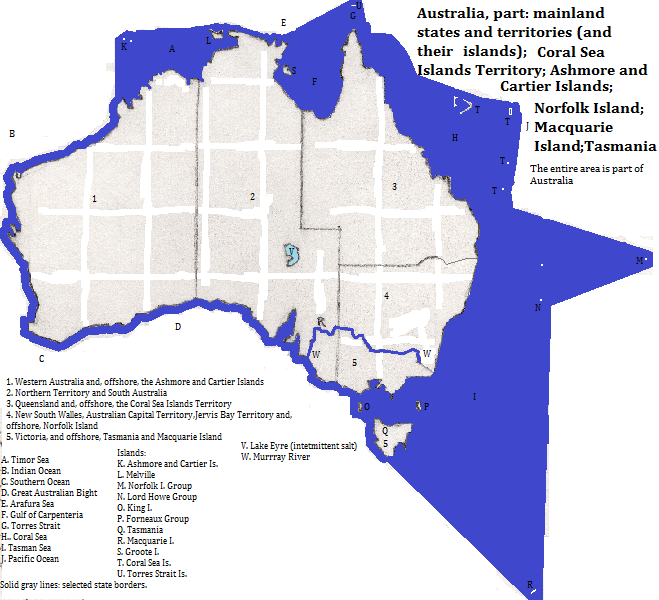
| To Duval Family Home Page | Oceania |
| To Chris Home Page | Australia and its possesions |
| To Earth (Geography Home Page) |
Most of this area consists of the continental landmass of Australia, the heart of Oceania. It is shaped like a kidney on its side, with a deep indent, the Gulf of Carpentaria, in the north and the island of Tasmania
The Western Plateau features several mountain ranges--none as high as 2000 meters, vast deserts and arid plains, and are speckled with salt 'lakes' that are rarely wet.
The Central Lowlands include a large artesian basin in the north, and the Murray-Darling
The Great Dividing Range starts at the Cape York Peninsula east of the Gulf of Carpentaria, and extends--close to the coast--all the way to the southeast corner of the nation, where it bends westward, staying near the south coast. Only in the south, in the Snowy Mountains, do the peaks top 2000 meters. The island of Tasmania is also rugged, reaching over 1500 meters.
Beyond the north coast is the world's longest barrier reef, almost 2000 kilometers long and including numerous islets.
Western Australia and the Ashmore and Cartier Islands
Northern Territory and South Australia
Queensland and the Coral Sea Islands Territory
New South Wales, Australian Capital Territory, Jervis Bay Territory and Norfolk Island
Victoria, Tasmania and Macquarie Island

There are over 20 million people in this area, very unequally distributed. Most live in the Eastern Coastal Plains and near the state capitals of Western and South Australia. About nine in every ten speak English as a first language; no other language accounts for more than one in twenty, and most of the remainder consists of urban immigrants from other parts of the world.
Relgious statistics vary wildly, but is is safe to way that more than 19 in 20 are culturally Christian, that most of those remain observant, and that observance is represented chiefly by Anglican Protestants and Roman Catholics, with other Christians together consituting less than either of these groups.
There are five metropolitan areas
Before the 17th century only three language groups are represented. The Trans New Guinea set is represented by one language spoken on some reefs in the Torres Straits Islands. Tasmanian languages were spoken on that island and Australian languages everywhere else. These groups may have been there for 20,000 years or more. The Australians followed spiritualist religions, with some common myths and other elements.
Contacts from the north had very little impact, but the arrival of the British overwhelmed local cultures, due to genocide, intentional cultural destruction, persistent slavery, aggressive Christian proselytyzing, and the pragmatic advangages of assimilation. Other Europeans were invited to join the English speakers and assimilate, and very recently Asians have been allowed to join them.
1. Tasmania is Oceania's fourth largest island, counting New Guinea, not counting the Australian mainland.
2. This combination is Australia's longest river. One of its tributaries is Australia's second longest.
3. Statistics keepers sometimes define some of the cities proper as small, and sometimes as including many suburbs.
4. Many of the remaining Protestants have joined in a Uniting Church.